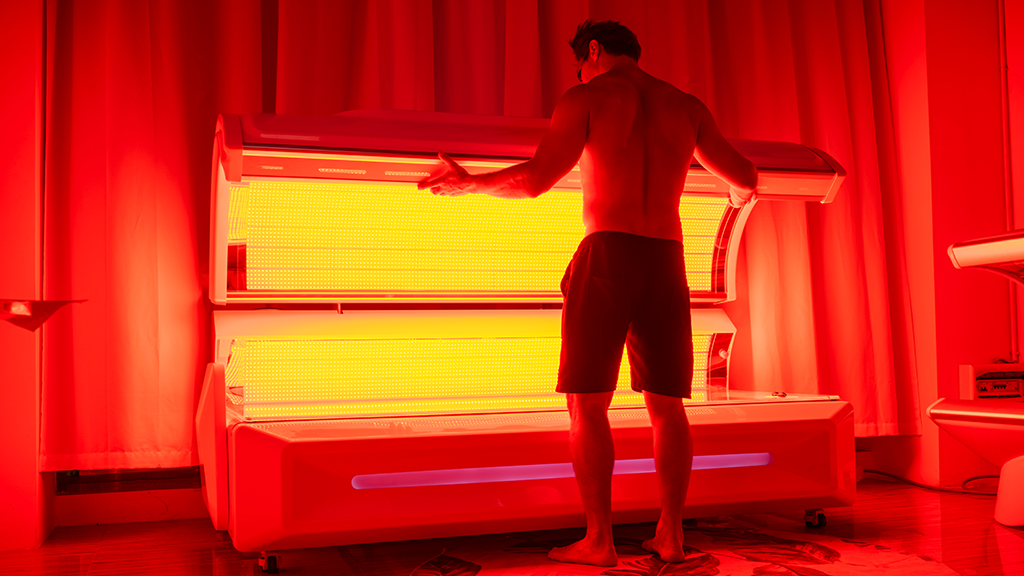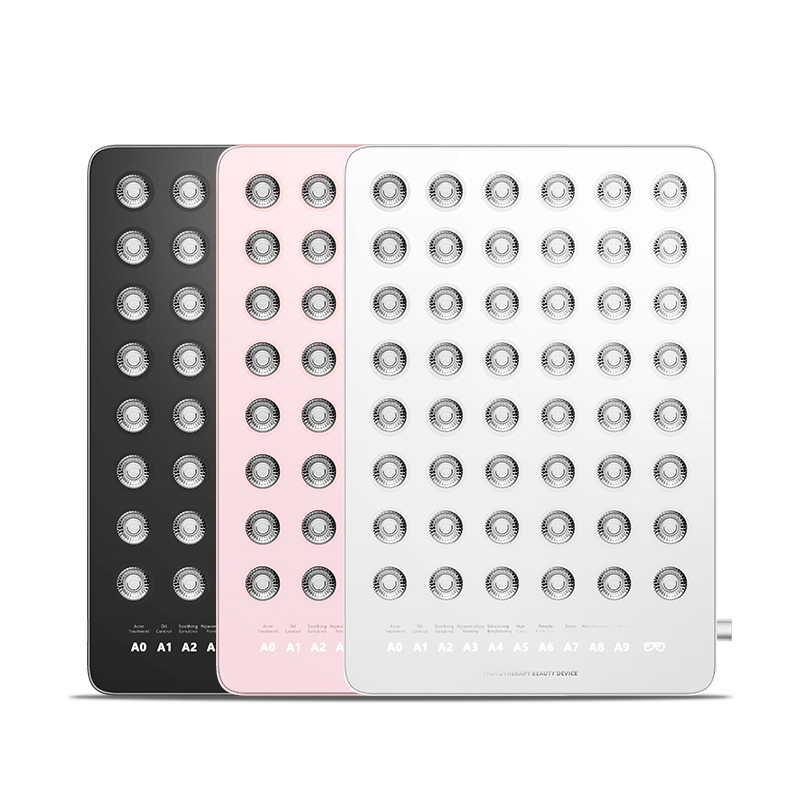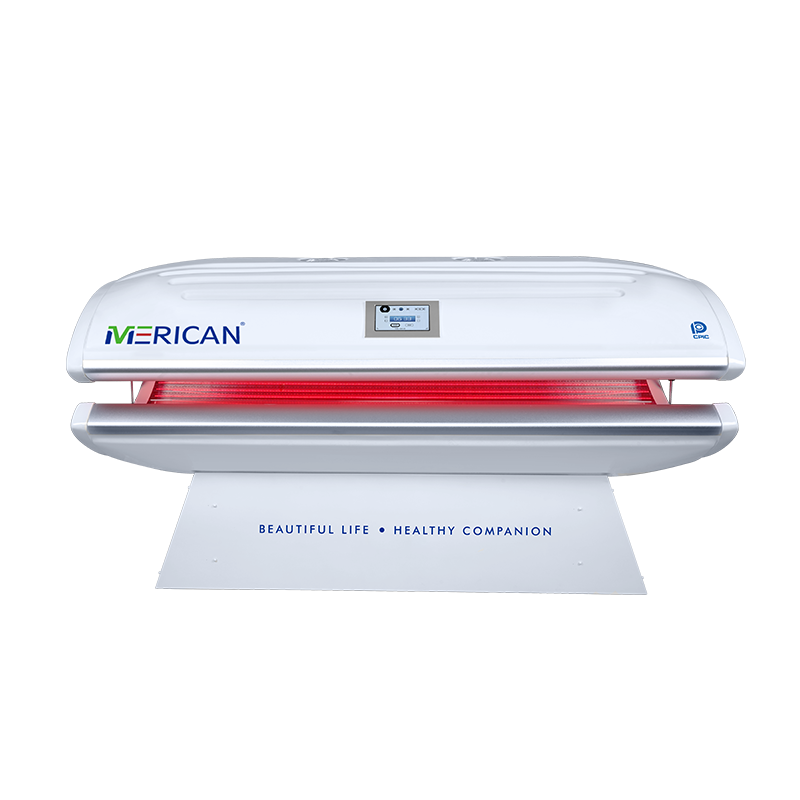Erste:Einführung in die Rotlichttherapie
Rotlichttherapie (RLT), oder Rotlichttherapie, ist eine therapeutische Technik, die rotes oder nahinfrarotes Licht mit geringer Leistung zur Behandlung einer Vielzahl von Hautproblemen und anderen körperlichen Beschwerden nutzt.
Die Rotlichttherapie wirkt auf die Mitochondrien, die „Kraftwerke“ in den Körperzellen. Mit mehr Energie, andere Zellen können effizienter arbeiten, wie zum Beispiel die Reparatur der Haut, Förderung des Wachstums neuer Zellen, und verbessert die Regenerationsfähigkeit der Haut. Bestimmte Zellen absorbieren bestimmte Lichtwellenlängen und werden zur Arbeit angeregt. Eine Rotlichttherapie kann dabei helfen, die Kollagenproduktion anzuregen, welches der Haut ihre Struktur verleiht, Festigkeit und Elastizität. Es kann auch die Produktion von Fibroblasten steigern, die Kollagen bilden. Kollagen ist Teil des Bindegewebes, das die Haut aufbaut. Zusätzlich, Es kann die Durchblutung des Gewebes erhöhen und zelluläre Entzündungen reduzieren.
RLT ist eine von der FDA zugelassene Behandlung, die zur Reparatur der Haut beiträgt, Muskelgewebe und andere Körperteile. Es nutzt rotes Licht geringer Leistung, um Mitochondrien zu aktivieren und zelluläre Stoffwechselprozesse anzukurbeln, um den Körper zu heilen und zu verbessern. Sicher und effektiv, Diese klinisch erprobte Behandlung fördert die natürliche Kollagenproduktion und hat sich als wirksam bei der Verbesserung der Hautgesundheit erwiesen, Linderung von Gelenkschmerzen, Förderung der Muskelwiederherstellung, stimuliert das Haarwachstum, und beschleunigt die Wundheilung.
Zweite:Rolle und Vorteile der Rotlichttherapie
(ich) Förderung der Kollagenproduktion
Untersuchungen haben gezeigt, dass eine Rotlichttherapie die Kollagenproduktion deutlich steigern kann. Eine Studie über 50 Frauen im Alter zwischen 40 Und 60 Habe das danach gefunden 8 Wochen Rotlichttherapie, die Teilnehmer’ Der Kollagenspiegel der Haut stieg durchschnittlich um 30%. Dadurch wurden Falten und Narben sichtbar reduziert. Kollagen verleiht der Haut Struktur, Festigkeit und Elastizität, und durch die Stimulierung der Kollagenproduktion von Fibroblasten, Die Rotlichttherapie verleiht der Haut ein jugendliches und gesundes Aussehen.
(ii) Verbesserung der Hautgesundheit
Die Rotlichttherapie hat positive therapeutische Wirkungen bei Hautproblemen wie Akne, Psoriasis und Rosacea. Es fördert das Wachstum von neuem, gesundem Hautgewebe und reduziert Entzündungen. Zum Beispiel, in einer Studie über 100 Akne-Patienten, Die Aknesymptome wurden danach deutlich reduziert 4 Wochen Behandlung mit Rotlichttherapie. Die Rotlichttherapie verbessert verschiedene Hautprobleme, indem sie den Stoffwechsel der Hautzellen reguliert und die Immunität der Haut stärkt.
(iii) Linderung von Gelenkschmerzen
Die Rotlichttherapie reduziert Entzündungen und Arthritis-Schmerzen. Es verbessert die Reparatur des Knorpels zwischen den Gelenken und reduziert Entzündungen durch die Stimulierung der zellulären Energieproduktion. Viele Patienten mit Arthritis verspüren nach einer Rotlichttherapie eine Schmerzlinderung und eine erhöhte Beweglichkeit der Gelenke. Eine Studie zeigte das danach 6 Wochen Rotlichttherapie, Arthritis-Patienten erlebten einen Durchschnitt 40% Schmerzlinderung.
(iv) Förderung der Muskelregeneration
Die Rotlichttherapie hilft, verzögerten Muskelkater zu reduzieren und sportbedingten Muskelverletzungen vorzubeugen, und verbessert die Widerstandsfähigkeit gegen Muskelermüdung. Sportler, die nach dem Training eine Rotlichttherapie anwenden, können die Muskelregeneration beschleunigen und Muskelermüdung reduzieren. Studien haben gezeigt, dass Sportler, die eine Rotlichttherapie erhielten, eine 30% kürzere Erholungszeit nach hochintensivem Training als diejenigen, die die Behandlung nicht erhielten.
(v) Fördert das Haarwachstum
Die Rotlichttherapie hat potenzielle Vorteile für das Haar. Es kann die Durchblutung und Sauerstoffversorgung steigern, Fördern Sie das Haarwachstum und verhindern Sie Haarausfall. Einige Studien haben herausgefunden, dass der Einsatz der Rotlichttherapie zur Behandlung von Patienten mit Haarausfall die Dichte ihrer Haare nach mehreren Monaten der Behandlung deutlich erhöhte. Die Rotlichttherapie unterstützt ein gesundes Haarwachstum, indem sie das Wachstum und den Stoffwechsel der Haarfollikelzellen stimuliert.
(vi) Beschleunigung der Wundheilung
Eine Rotlichttherapie kann die Genesungszeit von Wunden beschleunigen. Viele Studien haben gezeigt, dass es auch bei Wunden von Diabetikern sehr wirksam ist. Eine Rotlichttherapie kann die Zellproliferation und die Kollagensynthese fördern, Beschleunigung des Wundheilungsprozesses. In einer Studie über diabetische Wunden, Patienten, die mit Rotlichttherapie behandelt wurden, hatten a 50% Verkürzung der Wundheilungszeit im Vergleich zu unbehandelten Patienten.
Dritte: Empfehlungen für den Einsatz der Rotlichttherapie
Eine Anwendung der Rotlichttherapie vor dem Schlafengehen ist durchaus möglich, Die Auswirkungen und Nebenwirkungen müssen jedoch sorgfältig abgewogen werden.
Was die Aktion angeht, Die Rotlichttherapie fördert die Erholung und Reparatur des Körpers. Wenn Sie tagsüber intensiv Sport getrieben oder gearbeitet haben, Ihr Körper kann Symptome wie Müdigkeit und Muskelkater verspüren. Die Anwendung einer Rotlichttherapie vor dem Schlafengehen kann die Muskelregeneration fördern, Reduzieren Sie verzögerten Muskelkater, Verbessern Sie die Widerstandsfähigkeit gegen Muskelermüdung, und helfen dem Körper, sich im Schlaf besser zu erholen. Zusätzlich, Eine Rotlichttherapie kann die Kollagenproduktion fördern und die Hautgesundheit verbessern, und für diejenigen, die sich mit Hautpflege beschäftigen, Die Anwendung vor dem Schlafengehen kann einige Vorteile bieten. Auch, Die Rotlichttherapie hat potenzielle Vorteile für das Haar, Erhöhung der Durchblutung und Sauerstoffversorgung, Förderung des Haarwachstums und Vorbeugung von Haarausfall. Für Menschen mit Haarausfallproblemen, Eine Rotlichttherapie vor dem Schlafengehen kann hilfreich sein.
Jedoch, Im Hinblick auf Nebenwirkungen sind einige Probleme zu beachten. Bei falscher Anwendung, Eine Rotlichttherapie kann Symptome wie Überanstrengung der Augen verursachen, Lichtempfindlichkeit, Kopfschmerzen und Spannungsgefühl der Haut. Bei Verwendung vor dem Schlafengehen, Es ist besonders wichtig, direktes Licht auf die Augen zu vermeiden, um Augenbeschwerden zu vermeiden. Wenn Sie empfindlich auf rotes Licht reagieren, Es kann zu Hautreizungen und allergischen Reaktionen kommen. Zusätzlich, Eine längere Einwirkung von rotem Licht kann zu unangenehmen Symptomen wie Müdigkeit und Kopfschmerzen führen, was die Schlafqualität beeinträchtigen kann.
daher, Bei der Anwendung der Rotlichttherapie vor dem Schlafengehen werden folgende Maßnahmen empfohlen:
1. unter Anleitung eines Fachmanns, um die ordnungsgemäße Verwendung des Geräts sicherzustellen und Nebenwirkungen zu vermeiden.
2. Vermeiden Sie direkte Lichteinwirkung auf die Augen, entweder durch das Tragen einer Augenmaske oder die Verwendung eines lichtblockierenden Geräts.
3. Wenn Sie empfindlich auf rotes Licht reagieren, Sie können vor der Anwendung einen lokalen Hauttest durchführen, um festzustellen, ob eine allergische Reaktion vorliegt.
4. Kontrollieren Sie die Nutzungsdauer, Vermeiden Sie eine zu lange Einwirkung von rotem Licht. Allgemein gesprochen, Jede Verwendung sollte nicht überschritten werden 30 Minuten.
5. Beobachten Sie die Reaktion des Körpers nach der Anwendung, wenn Beschwerden auftreten, Sie sollten die Anwendung rechtzeitig beenden und geeignete Behandlungsmaßnahmen ergreifen.
Abschließend, Ob eine Rotlichttherapie vor dem Schlafengehen angewendet werden soll, muss je nach den individuellen Umständen abgewogen werden. Wenn es richtig angewendet werden kann und darauf geachtet wird, Nebenwirkungen zu vermeiden, Eine Rotlichttherapie kann dem Körper vor dem Zubettgehen einige Vorteile bringen. Jedoch, wenn Zweifel oder Unsicherheiten bestehen, Am besten konsultieren Sie zunächst einen Fachmann.
Zusammenfassung der Anwendung der Rotlichttherapie
Die Rotlichttherapie ist eine nicht-invasive und oft sichere Methode, um Ihren Körper auf einen erholsamen Schlaf vorzubereiten.
Bei der Rotlichttherapie werden bestimmte Wellenlängen des roten Lichts auf die Körperzellen angewendet, um den Zellstoffwechsel und die Energieproduktion zu fördern. Durch die Anwendung einer Rotlichttherapie vor dem Schlafengehen, Sie können seine Fähigkeit nutzen, die Erholung und Reparatur Ihres Körpers zu fördern, Schaffung der Voraussetzungen für einen erholsamen Schlaf.
Im Hinblick auf die Verbesserung der Durchblutung, Die Rotlichttherapie erweitert die Mikrogefäße und erhöht die Durchblutung. Dies trägt dazu bei, alle Teile des Körpers mit Nährstoffen zu versorgen, einschließlich Gehirn und Muskelgewebe. Vor dem Schlafengehen, Eine gute Durchblutung kann dem Körper helfen, sich zu entspannen, Reduzieren Sie Müdigkeit und bereiten Sie es auf den Schlaf vor. Laut Recherche, Durch die Rotlichttherapie werden die Blutgefäße erweitert, erhöht die Durchblutung, und verbessert die Sauerstoffsättigung und Nährstoffversorgung des lokalisierten Gewebes, Dies hilft, Schmerzen zu lindern und die Wundheilung zu fördern. Zum Beispiel, in einigen klinischen Studien, Patienten mit diabetischen Fußgeschwüren, die mit Rotlichttherapie behandelt wurden, erlebten eine deutliche Verkleinerung ihrer Geschwüre und heilten viel schneller als bei herkömmlichen Behandlungen. Dies deutet darauf hin, dass die Rotlichttherapie einen erheblichen Einfluss auf die Verbesserung der Blutzirkulation hat, Eine gute Durchblutung ist für die körperliche Entspannung und die Schlafqualität vor dem Zubettgehen unerlässlich.
Im Hinblick auf die Förderung von Reparatur und Regeneration, Die Rotlichttherapie beschleunigt den Zellstoffwechsel und verbessert die Zellregeneration. Nach einem Tag voller Aktivität, Der Körper kann leichte Verletzungen aufweisen, wie etwa Muskelmikroschäden. Eine Rotlichttherapie vor dem Zubettgehen kann die Reparatur dieser Schäden beschleunigen, Dadurch kann sich der Körper im Schlaf besser erholen. Es wirkt sich auch positiv auf die Reparatur der Haut aus, trägt dazu bei, dass es in einem gesunden Zustand bleibt.
Jedoch, Bei der Anwendung der Rotlichttherapie sind einige Dinge zu beachten. Erstens, Stellen Sie sicher, dass Sie unter der Anleitung eines Fachmanns stehen, der sich mit der richtigen Verwendung und den zu treffenden Vorsichtsmaßnahmen auskennt. Zum Beispiel, vor der Durchführung einer Rotlichttherapie, Der Arzt reinigt und sterilisiert die Haut des Patienten, um sicherzustellen, dass der Behandlungsbereich sauber und hygienisch ist. Gleichzeitig, Der Arzt stellt die Parameter des Rotlichttherapiegeräts entsprechend den spezifischen Bedingungen des Patienten ein, wie zum Beispiel die Behandlungszeit, Lichtintensität und Behandlungsfrequenz. Zweitens, Es ist wichtig, eine direkte Lichteinwirkung auf die Augen zu vermeiden, um Schäden zu vermeiden. Rotlichttherapiegeräte können die Augen und den Bauch schwangerer Frauen grundsätzlich nicht bestrahlen, insbesondere ultraviolettes Licht, Blaues Licht kann Schäden an der Hornhautlinse und der Netzhaut verursachen, Die Bestrahlung des Bauches schwangerer Frauen mit einem Rotlichttherapiegerät beeinträchtigt die gesunde Entwicklung des Fötus. Zusätzlich, Schwangere und stillende Frauen sollten die Rotlichttherapie mit Vorsicht anwenden. Für Menschen, die empfindlich auf Rotlicht reagieren, Sie können vor der Anwendung einen lokalen Hauttest durchführen, um festzustellen, ob eine allergische Reaktion vorliegt. Wenn Beschwerden auftreten, Beenden Sie die Anwendung und ergreifen Sie geeignete Behandlungsmaßnahmen.
Abschließend, Rotlichttherapie, als nicht-invasive und meist sichere Methode, kann den Körper bei richtiger Anwendung auf einen erholsamen Schlaf vorbereiten. Jedoch, Professionelle Ratschläge und Vorsichtsmaßnahmen müssen sorgfältig befolgt werden, um die positiven Effekte zu maximieren und gleichzeitig mögliche Nebenwirkungen zu vermeiden.


























